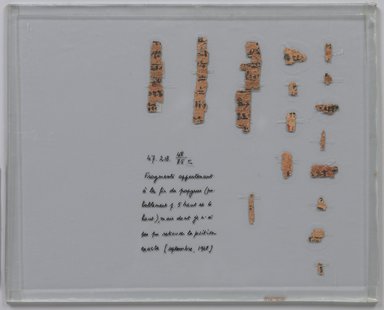
Medium: Papyrus, ink
Geograhical Locations:
Dates:589-525 B.C.E.
Dimensions: Overall: 10 5/8 × 68 7/8 in. (27 × 175 cm) a: Glass: 15 13/16 x 27 5/8 in. (40.2 x 70.2 cm) a: Object: 10 13/16 x 26 3/16 in. (27.5 x 66.5 cm) b: Glass: 15 3/4 x 29 1/2 in. (40 x 75 cm) b: Object: 10 11/16 x 25 3/8 in. (27.2 x 64.5 cm) c: Glass: 15 3/4 x 22 3/16 in. (40 x 56.3 cm) c: Object: 10 13/16 x 18 3/8 in. (27.5 x 46.7 cm) d: Small Bo
Collections:
Accession Number: 47.218.48a-f
Image: 47.218.48e_47.218.85e_PS11.jpg,
Catalogue Description: Hieratic "snakebite papyrus". Papyrus roll inscribed on recto only in red and black Hieratic. Small hand. Extant text consists of six columns, comprising 25-29 lines per column, listing the names of a number of species of snakes, a description of their appearance, the effect of their bites, and treatment therefor. Thirty-four species of snakes are dealt with. The two accession numbers are the result of the upper half of the papyrus (.48) becoming separated from the lower half (.85) while they were still rolled. 47.218.48/.85A (47.218.48d): 100+ fragments, mostly quite small. Many of them show traces of Late Period hieratic writing. Several fragments belong to 47.218.87A (the Eye Papyrus). The relatively small size of most of these fragments makes the reading of only a few signs possible; assigning most of these fragments to the texts from which they come is not possible at the present moment. Condition: Exceptionally good. No small fragments.